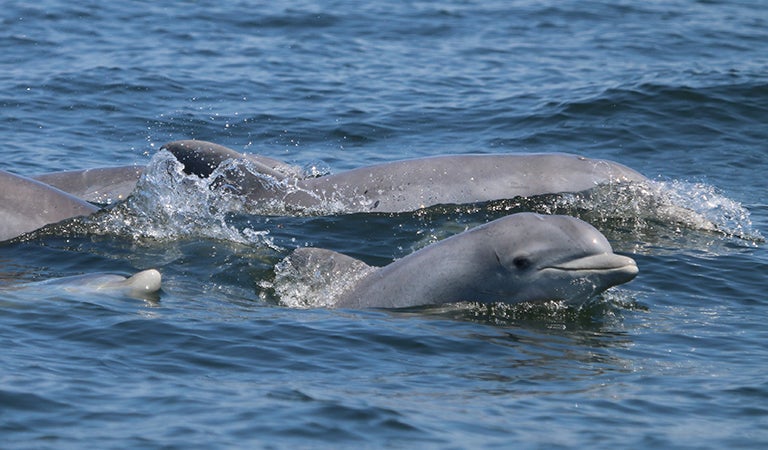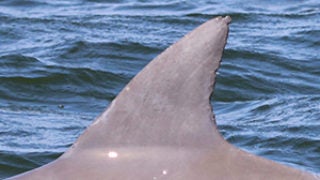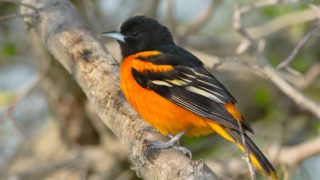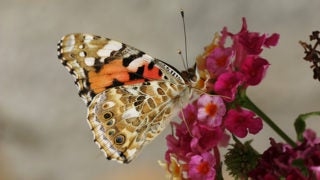The first evidence that the Potomac River is a breeding area for wild bottlenose dolphins has been gathered by graduate students working with Georgetown biologist and dolphin expert Janet Mann.
The evidence was gathered on August 17 as part of the Potomac-Chesapeake Dolphin Project (PCDP), initiated by the biology and psychology professor nearly five years ago to make the first-ever study of dolphins in the Potomac.
Mann created the project after studying bottlenose dolphins in Shark Bay, Australia, for more than three decades.
Second Documented Birth
“I have spent 32 years studying wild bottlenose dolphins – logging tens of thousands of hours observing them, particularly mothers and calves,” Mann says. “Yet I have never seen a birth or even evidence of a recent birth. This recent sighting is really exciting.”
While bottlenose dolphins are the most studied species worldwide, she says there has been only one other documented birth, in 2013 off the coast of Georgia.
Two graduate students – Ann-Marie Jacoby (C’13) and Melissa Collier (G’23) – were following a group of about 50 dolphins in the Potomac River near Lewisetta, Virginia, when Jacoby noticed a cloud of blood and shortly afterward a small calf with a “slightly bent and wobbly fin” surfaced and then swam alongside its mother.
At birth, the calves’ fins, which straighten out within a few hours, are completely flopped over to one side.
Beyond Excited
“At first, I was very alarmed by the cloud of blood, but there were no apparent signs of injury or predation – the dolphins were just traveling down the river,” says Jacoby, who has worked with Mann since her undergraduate years at Georgetown. “I ran through the possible reasons for the blood and told my team to look out for an extremely small newborn. Lo and behold, a mom with a newborn, whose fin was still slightly bent, surfaced in front of and in line with the cloud of blood.”
“At that point, I was beyond excited, because it very likely had been born recently and in the Potomac,” adds the Georgetown graduate, who is now a Ph.D. student at the Duke University Marine Lab. “To me, it’s the most compelling evidence we have to date that dolphins are coming into the Potomac River to give birth, which is amazing.”
Collier, a graduate student in Georgetown’s biology department, also witnessed the birth.
“Helping the PCDP pilot their research in the Potomac and documenting new findings such as this has been one of the highlights of my graduate career at Georgetown,” she says. “There’s something really special about being one of the few researchers studying this unique and understudied group of dolphins, and I’m excited to continue working with them for my dissertation work.”
Mink, Ginsburg & Reagan
The team named the mother dolphin the students observed after the late Patsy Mink, a former member of Congress representing Hawaii who co-authored the Title IX Amendment of the Higher Education Act. The calf was named after Mink’s daughter, Gwendolyn, a former academic-turned-independent-scholar who writes about law, politics and gender and American society.
The PCDP has a tradition of naming dolphins, who have been named everything from Ruth Bader Ginsburg to Ronald Reagan, after significant U.S. leaders.
This past spring, in partnership with the Potomac Conservancy, the project held a public contest to name two adult dolphins – now called “Mac” and “Chessie.”
Initial Surprise
Mann says her team was initially surprised to find so many dolphins in the Potomac River, and, earlier this month, to learn that they also give birth there.
“We have been trying to understand why dolphins come into the Potomac River and the Chesapeake Bay,” Mann says. “We see some very young calves and we see lots of mating behavior, but this is the most definitive evidence we have that they have their calves here.”
The biologist says her team observes the dolphins in the Potomac River between April and October, with numbers peaking during the summer months.
1,000 Dolphins
The roughly 1,000 wild bottlenose dolphins using the area have been recorded traveling as far up the Potomac as the Rt. 301 bridge, which spans the river between Newburg, Maryland, and Dahlgren, Virginia, about 70 miles away from DC.
“It is thought that these animals are from multiple populations because dolphins seen in the Potomac River have also been sighted off of North Carolina and New Jersey,” Mann says, “and some groups have population-specific characteristics not shared by other groups of dolphins.”
Mann is also collaborating with Google’s artificial intelligence engineers on individual identification of wildlife, including dolphins, through images.
HELP GEORGETOWN SCIENTISTS SPOT DOLPHINS IN THE POTOMAC RIVER



